
Latest News
-
Preservationists Praise Rehab Plan for Old Morgue
By Craig Smith, PITTSBURGH TRIBUNE-REVIEW
Friday, March 11, 2011http://www.pittsburghlive.com/x/pittsburghtrib/lifestyles/s_726879.html
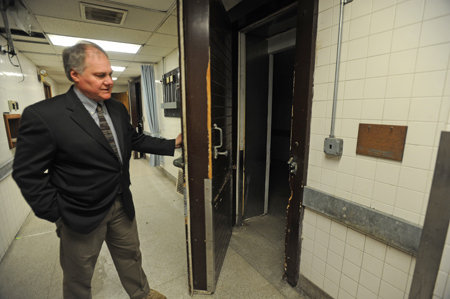
Sam Taylor, principal architect/building manager for Allegheny County department of public works, gives a tour of the old Allegheny County Morgue before it undergoes a $4 million renovation. James Knox | Tribune-Review
As a 14-year-old growing up in Oakland, Sam Taylor went to the Allegheny County Morgue at the urging of his friends to see the bodies on display.
It was a tradition for generations of Pittsburgh teens, he said. Some even took their prom dates.
“When you’re 14, you think you’re invincible,” said Taylor, 59, of Mt. Lebanon. “There was this yellowish light, and the bodies were kind of leaned back.”
Taylor, the county’s principal architect/building manager, is overseeing a $4 million renovation of the former morgue. The building, completed in 1903, was moved the length of a football field in 1929 to make way for the County Office Building.
Allegheny County expects to seek bids for demolition inside the building in late April or early May. That will create an additional 30,000 square feet of office space, while preserving many of the building’s unique features. The plan is to reuse transoms, stair railings and courtroom banisters, Taylor said.
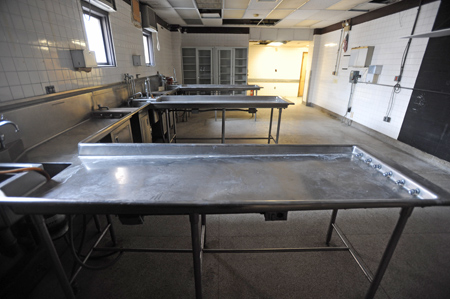
The autopsy room inside the old Allegheny County Morgue will be transformed into a new use. James Knox | Tribune-Review
A $900,000 project that included installing a terra cotta roof and masonry work was completed in 2006.
Officials haven’t determined who will use the space.
“We have a number of departments using leased space, including the Law Department and Economic Development,” said county spokesman Kevin Evanto.
Architect Paul Apostolou, who made a trip to the morgue when he was in high school, said a big part of the project will be undoing the “sledgehammer and hacksaw” approach to renovations over the years.
Preservationists praise the effort.
“I think they are trying to treat it very well for a building that no longer suits its original purpose because of modern technology,” said Arthur Ziegler, president of Pittsburgh History & Landmarks Foundation. “It’s a notable building in the government complex.”
The city designated the Frederick Osterling-designed building as a Pittsburgh landmark in 2002. Osterling, one of Pittsburgh’s premier architects, designed the county jail expansion of 1904 and Union Arcade (1915-17), which became Two Mellon Bank.
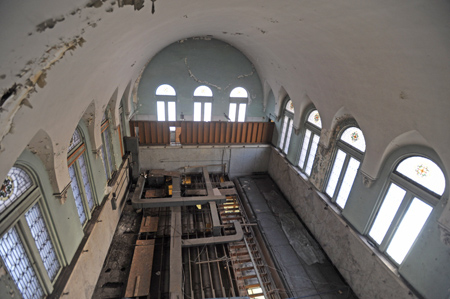
The "chapel" of the vacant old Allegheny County Morgue Friday was a place of prayer in a somber place. James Knox | Tribune-Review
The morgue building was designed to visually match the jail and courthouse, but by 1929, county government needed more space, according to a history of the building compiled by History & Landmarks. Officials decided a consolidated office building on Ross Street between Forbes and Fourth avenues would be the most efficient. That forced them to relocate the morgue.
The move was an enormous undertaking that took about three months. Work inside the building by the coroner and his staff continued without interruption, though. Temporary gas, water and sewer lines were connected and maintained on a 24-hour basis.
Huge timberwork and steel rails were used to move the building, which had to be lifted to the same height at the same moment. That ticklish maneuver was carried out by 100 men from a Balkan tribe — specialists in moving buildings from the “old country.”
They manned screw jacks that they gave a quarter turn every time a whistle sounded, until the three-story building was 27 feet in the air. It then was moved onto a system of beams designed by Kress-Oravetz Co. and slowly, laboriously pulled by cable to the foundation at 542 Fourth Ave.
Once there, Taylor said, they had to “shoehorn” the building between two structures.
In 2005, voters approved a referendum that eliminated the coroner as a row office, returning it to its early roots as an appointed position, now called medical examiner. The medical examiner’s office relocated in 2009 to a building in the Strip District.
-
Historic Designation Rejected for Civic Arena
Wednesday, March 02, 2011By Mark Belko, Pittsburgh Post-GazetteThe city Historic Review Commission refused to designate the Civic Arena a city historic structure today, a setback for those seeking to save the old building.
The panel voted 6-0 to reject the building’s nomination, reversing an earlier decision to designate the arena as a historic structure.
It followed the same pattern that occurred in the early 1990s when the commission gave preliminary approval and then rejected it in a final vote.
The decision is a setback for local preservationists who have been trying to stop the demolition of the 49-year-old arena. It is a victory for the Penguins, who want to use the site for housing, offices and shops.
Before he voted, Ernie Hogan, the commission’s acting chairman, said he did not think the arena met any of the 10 criteria for nomination.
Rob Pfaffmann, leader of Reuse the Igloo, said afterwards he was very disappointed with the decision but would continue the battle to save the structure.
The fight is far from over. The city planning commission and ultimately city council still must take up the nomination.
-
PHLF Receives Major Geographical Information Systems Grant
PHLF News
February 28, 2010The Environmental Systems Research Institute (Esri), base in Redlands, California, approved a software grant for mission-related work of specialized GIS software, ArcInfo, to the Pittsburgh History & Landmarks Foundation that has a valued at $160,000. The award was announced February 25.
“PHLF does a significant amount of work in historic and urban inner-city neighborhoods,”, said Landmarks Chief Information Officer Ronald C. Yochum, Jr., “and understanding the raw data we collect via sophisticated mapping technology helps us better visualize and achieve our goals of successful and sustainable neighborhood revitalization.”
PHLF has been using a version of ESRIs ArcView GIS software to produce maps for our efforts in Wilkinsburg, PA., however we wanted to expand the level of spatial analysis of the raw data, so Mr. Yochum approached Esri and applied for their Non-profit Organization program.
Landmarks will be using Esri’s ArcInfo GIS software for an upcoming quantitative analysis of PHLF activities over the history of the company and will be developing maps of the regions historic assets. The software will also help support staff projects in our education, neighborhood development, Main Street and Elm Street programs, and other bricks and mortar projects.
Esri offers a variety of programs to support groups working for social and environmental benefit. Organizations use GIS to analyze complex situations, visualize problems, and create plans and solutions, as well as increasing efficiency, reducing costs, and helping people make faster and better decisions. More information on this software can be found at www.esri.com.
-
PHLF Wins Allegheny County Grant for Community Garden Project
An urban farming and community garden project that started as a part of PHLF’s vacant lot reuse initiative in Wilkinsburg was one of three recipients of a $20,000 grant from Allegheny County in February. The funds will help residents of Hamnett Place a National Register-listed historic district cover implementation costs, including the purchase of gardening tools and materials, seedlings, and technical expertise over a two-year period. Currently, PHLF is in partnership with the non-profit social enterprise Growth Through Energy and Community Health (GTECH Strategies) to help the community craft a site map of the garden on a 19,000 square-foot lot at 502-504 Jeanette Street.
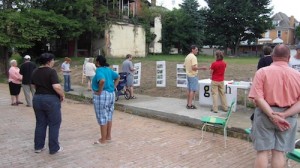
-
Now Available: August Wilson: Pittsburgh Places in His Life and Plays
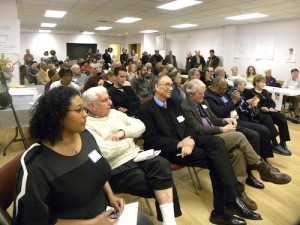 More than 200 people attended the book-signing celebration hosted by the Pittsburgh History & Landmarks Foundation, Historic Hill Institute, and Hill Community Development Corporation on Saturday, February 26 at Ebenezer Baptist Church in Pittsburgh’s Hill District. “This guidebook to places associated with playwright August Wilson’s life and work is the result of the cooperative efforts of many people,” said Louise Sturgess, executive director of Landmarks, “and its power is not to be underestimated in terms of its substance and impact.”
More than 200 people attended the book-signing celebration hosted by the Pittsburgh History & Landmarks Foundation, Historic Hill Institute, and Hill Community Development Corporation on Saturday, February 26 at Ebenezer Baptist Church in Pittsburgh’s Hill District. “This guidebook to places associated with playwright August Wilson’s life and work is the result of the cooperative efforts of many people,” said Louise Sturgess, executive director of Landmarks, “and its power is not to be underestimated in terms of its substance and impact.”Lead donors Kenya Boswell from BNY Mellon Foundation of Southwestern Pennsylvania and Gerry Kuncio of the Pennsylvania Historical and Museum Commission offered brief remarks, along with the authors Laurence A. Glasco, Christopher Rawson, Kimberly C. Ellis, and Sala Udin. The authors and PHLF presented complimentary books to high schools, colleges, and libraries in the city and county.
The guidebook was supported by a Preserve America grant from the National Park Service, administered under the Preserving African American Heritage in Pennsylvania program of the Pennsylvania Historical and Museum Commission. The Multicultural Arts Initiative and 75 PHLF members and friends also contributed to the guidebook.
August Wilson is one of America’s great playwrights. He lived in Pittsburgh from his birth in 1945 to 1978, when he moved to St. Paul, MN, and later to Seattle, WA. He died in 2005 and is buried in Pittsburgh. Wilson composed 10 plays chronicling the African American experience in each decade of the twentieth century––and he set nine of those plays in Pittsburgh’s Hill District. He turned the history of a place into great theater.
“It’s very exciting to be part of an excellent project that results in a resource that will help make Wilson’s life and work more accessible to the public, become the basis for public tours, and encourage people to care for and preserve the Pittsburgh places connected with the African American playwright,” said Gerry Kuncio.
To order a book ($8.95 plus sales tax), click here.
-
Historic Religious Properties and New Members Reception: March 2
The Historic Religious Properties Committee awarded $78,600 in 14 grants and five Technical Assistance awards to congregations in Pittsburgh and Allegheny County. An Awards Reception will be held from 3 to 3:45 pm in the Grand Concourse Restaurant Board Room on March 2. George Dorman, chairman of the HRP Committee, and PHLF Board Chairman Mark Bibro will give brief remarks.
Immediately following, from 3:45 to 5:00 pm award recipients and new PHLF members will be invited to tour PHLF offices and libraries on the fourth floor of The Landmarks Building at Station Square.
Congratulations to the following grant recipients:
- Congregation Poale Zedeck, Squirrel Hill, for brick pointing and masonry repairs.
- First Presbyterian Church of Edgewood, for refinishing of exterior doors.
- First Presbyterian Church of Pittsburgh, Downtown, for refinishing of exterior doors.
- First Trinity Evangelical Church, Oakland, for repairing box gutters and replacing missing slates.
- Mt. Lebanon Presbyterian Church, stained glass window restoration.
- Pittsburgh Mennonite Church, Swissvale, for brick pointing.
- Sacred Heart Church, Shadyside, for stained glass window restoration
- South Side Presbyterian Church, for replacement of main roof.
- Stewart Avenue Evangelical Lutheran Church, for brick pointing and masonry work.
- St. Nicholas Catholic Church, Millvale, for repair and repainting of the exterior woodwork on the main structure of the church.
- St. Paul Baptist Church, Pt. Breeze, for box gutter relining and replacing missing slates.
- Waverly Presbyterian Church, Regent Square, for masonry repairs on main entrance stairway area.
- The Byzantine Seminary, in Perry Hilltop, received a grant from The Kim and Miller Family Fund at PHLF, payable over a four-year period, to help with repairs.
- Calvary United Methodist Church, in Allegheny West, received a grant from the Barensfield Fund at PHLF, to help with its handicapped-ramp project.
In addition, this year’s Barensfeld Fund Grant, of $1,100 was awarded to Calvary United Methodist Church in Allegheny West, to go toward the church’s handicapped ramp project.
The following received Technical Assistance Awards:
- Bethesda Presbyterian Church, Homewood
- Brown AME Chapel, Central North Side
- Ethnan Temple Seventh Day Adventist Church, Wilkinsburg
- Greenfield Presbyterian Church, Greenfield
- Jesus’ Dwelling Place, North Braddock
-
New President Named for Landmarks Community Capital Corporation.
Pittsburgh— We are pleased to announce that Michael Sriprasert, director of Real Estate Development, for the Pittsburgh History & Landmarks Foundation has also been named President of Landmarks Community Capital Corporation. This subsidiary was created in 2007 to undertake various forms of community revitalization activity. Since then, LCC has been repositioned as the lending arm of PHLF and will house all the loan funds, which serve non-profit and for-profit organizations.
Sriprasert, 30, who joined the PHLF staff five years ago, has been active in assisting the Board in this new focus. Under his leadership, LCC has applied for designation as a Community Development Financial Institution from the United States Treasury Department and received a grant from Treasury to help formulate the program.
“I am very excited at the opportunities LCC has to expand lending for preservation related projects in Pittsburgh and beyond. We will be focusing our efforts on increasing the pipeline of deals and raising additional capital for lending,” said Sriprasert.
Significant initial capital to launch LCC was provided by the Sarah Scaife and Allegheny Foundations, charities of Richard M. Scaife.
A graduate of Kenyon College, and Carnegie Mellon University’s Heinz College of Public Policy and Management, Sriprasert is also a 2011 candidate for the Master’s of Business Administration degree at CMU’s Tepper School of Business.
-
Fairview Park in Delmont Gains National Historic Status
Thursday, February 24, 2011By Laurie BaileyFairview Park in Delmont Gains National Historic Status
It’s important for retired history teacher Barbara Calloway that her children and grandchildren realize the impact of Salem Township’s Fairview Park on her own family and a generation of area African-Americans.
“They really can’t imagine the whole segregation thing. It’s part of our integrity, our history and part of who we are,” she said.
The park was selected earlier this month to be on the National Register of Historic Places. It was developed in 1945 by the Monongahela Valley Sunday School Association — a group of African-American churches from Westmoreland and Allegheny counties. At a time when segregation restricted access to other public amusement parks, Fairview Park was a place the African-American community could call its own.
“The designation is a recognition of what the people who founded the land had to go through,” Fairview Park Association president Ernest Jackson said.
The idea for a safe, welcoming place for African-American families, many from urban communities, to have fun and fellowship was actually conceived in 1918, Mr. Jackson said.
“No banks were lending money for land to black folks at that time,” he said. A banker himself, Mr. Jackson is vice president of operations for Dollar Bank.
People put up their own cash, even mortgaged their homes to develop the 100 acres of land where a roadside gas station and restaurant once stood along Route 22. “It wasn’t an easy transaction,” Mr. Jackson said.
By the 1940s and 1950s, the park established itself as the first African-American-owned amusement park and the place to go for church picnics and other gatherings. In its heyday, it featured a roller coaster and merry-go-round for small children, a swimming pool, softball fields, playground equipment, petting zoo and even hot air balloon rides.
“We took our picnic baskets and visited. The church picnic was the highlight of the year,” said Mrs. Calloway, of Point Breeze. Most churches had buses to transport those without cars to the Westmoreland County park.
“If you trace the history of the Civil Rights movement, you could determine when the park was most popular,” Mr. Jackson said.
Attendance started to decline in the late 1960s with the Civil Rights movement.
As money was needed throughout the park’s history, parts of the land were sold, including 33 plots that created the first black community in Salem Township. Part of the land was sold to pay real estate taxes — a cost that should have never occurred, Mr. Jackson said. Because the proper paperwork had not been filed, tax-exempt, non-profit status wasn’t official until 1998.
Now the association’s goal is to develop the park, which is still functional and used by a variety of groups. Costs for maintaining the existing 52 acres come entirely from donations, mainly from the dozen or so churches actively involved in the association. Volunteers cut the grass and do repair work.
But significant funding is required to meet the park association’s short term plans for updating the existing three shelters and bathroom facilities, playground equipment and ball field. The group is hoping to find someone to offer expertise in grant writing, Mr. Jackson said.
Along with its new national historical status, the park is eligible for consideration in federally assisted projects and qualifies for federal grants for historical preservation when funds are available, according to the website for the National Register of Historic Places: www.nps.gov/nr.
The association has a dream of further developing the park into a retreat center, providing facilities for church groups and businesses.
“With over 50 acres of land, there are many things we could do,” Mr. Jackson said.
But for now, as in the early days, church picnics successfully prevail, introducing today’s children to old-fashioned traditions like sack races, baking contests and bingo.
“They are things that kids don’t do now, but once they catch on, it gets competitive,” Mr. Jackson said.

